Once again about the Vyazma airborne operation
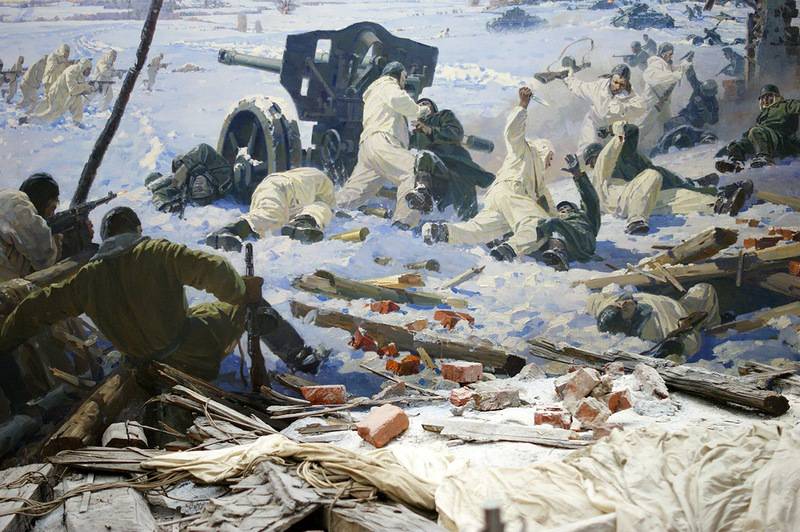
During the exercises of the air forces of the Moscow Military District, for the first time in the world of 2 August 1930, a small parachute paratrooper and materiel for him were sent to the rear of the “enemy”. This date is considered to be the birthday of the Soviet airborne troops. In subsequent years, there was a rapid growth of the airborne troops (Airborne Forces). Created autotroops detachments, airborne battalions, regiments and brigade special purpose. At the same time, experimental and then mass domestic production of parachutes, parachute containers, platforms for heavy equipment, suspended cabins for paratroopers and materiel, gliders was organized. In 1938, the Airborne Forces are removed from the Air Force and transferred to the Ground Forces.
On the eve of the war, in May 1941, the deployment of five airborne corps, numbering more than 8 thousand people each, began on the basis of the airborne brigades (airborne brigades). Staffing with them was completed by June 1, however, they did not manage to get fully staffed weapons, equipment, and landing equipment of the corps. Since the military transport aviation was not, as transport aircraft used the bombers TB-1, TB-3, R-5 and aircraft GVF ANT-9, ANT-14, PS-84, P-5.
The issues of conducting amphibious operations are reflected in the temporary Field Charter 1936 of the year and in the draft Manual on the operations. About the rear support of the landing forces in these documents was mentioned only in the most general form. The draft Field Manual 1941 of the Year and the first Guide to Combat Airborne Use deal more extensively with the planning of airborne operations and their logistics.
According to pre-war views, the preparation of the rear of the assault force included the manning of subunits, units and formations by personnel, weapons, equipment, parachute equipment and tara, ammunition, fuel, food and other tangible assets, as well as training in loading tangible assets into parachute parachuting. (PDT), loading them into airplanes and unloading, a comprehensive study of the area of upcoming actions and appropriate training of military transport aviation personnel (BTA).
Not all the training activities for the Airborne Forces and the VTA were able to be completed by the beginning of the Patriotic War, which caught the airborne corps at the time of formation and coordination. The difficult situation at the front forced the high command to enter them into battle as rifle formations. However, in the first period of the war, small tactical landing forces were used in the battles near Kiev, Odessa, and on the Kerch Peninsula. 4 September 1941, the Airborne Forces were allocated to an independent branch of service. All their units and formations were transferred from the front to the direct subordination of the Office of the Commander of the Airborne Forces. The provision on airborne forces, declared by the order, determined that all parachute, landing and air-glider units are at the disposal of the People's Commissar of Defense and are used only according to his instructions and for their intended purpose.
More than 50 tactical and two operational airborne assault forces were thrown out and landed during the war years. The Vyazma airborne operation is of the greatest interest. Airborne combat actions are described in sufficient detail in articles and books. However, the issues of logistical support, as a rule, they covered very little. Meanwhile, logistics support was of great importance for the course and results of this operation.
The Vyazemsky airborne operation (January 27 - June 24 1942) began at the final stage of the offensive of the Western and Kalininsky fronts, conducted after the counteroffensive near Moscow, when the resistance of the enemy increased, and the rate of advance of our troops faded. In order to assist the front forces in defeating the German Vyazma-Rzhev-Yukhnovsky group, the Supreme Command Headquarters decided to land an airborne assault force in the German rear. The headquarters of the Airborne Forces with the participation of the Air Force headquarters to 16 on January 1942 of the year developed a plan of the airborne operation 4 of the airborne corps of Major General A.F. Levashov. The issues of rear support of the landing force were practically not reflected in it. The landing of 4 VDK (8, 9, 214 vdbr and other parts) was decided to carry out from the Kaluga airfield center in the area of Vyazma. Since it was planned that independent combat operations of corps units in the enemy rear would last no more than 2-3 days, after which they would be connected with the advancing formations of the Western Front, the Airborne Troops Headquarters or the Western Front Headquarters did not develop a plan for the operation.
However, the operation was delayed for almost five months. The element of surprise landing was not achieved. The concentration of 4 airborne troops and military transport aircraft near the front line went unacceptably long, under the daily observation and strikes of enemy aircraft.
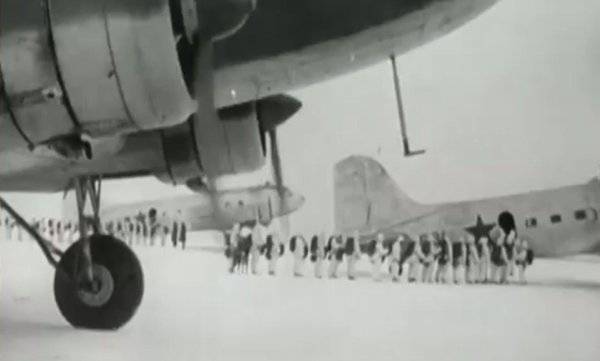
The landing dates, composition, tasks and areas of operations of the landing force were updated and changed many times. This complicated the planning, organization and implementation of the logistics of the troops. The rear control body of 4 VDK was the department of the rear of the corps headquarters, consisting of the chief and his assistants for the types of supplies (artillery, food, clothing). The corps had no rear units and institutions. The logistics department planned and supervised the material support of the formations and units from the respective district stores. Aircraft technical, engineering, airfield and parachute property of the brigade received from the warehouses of the Air Force District and the center. The sanitary service was not part of the logistics department, but the head of the sanitary service of the corps was subordinate to his chief.
The Vdb had an administrative and business unit, which included a chief of technical supply with an assistant for fuel and lubricants, military technical and automotive equipment, a brigade quartermaster with the chiefs of supply services (food and clothing), the chief of artillery supply and financial allowances. Each brigade had small warehouses (ammunition, food and clothing), artillery and automotive parts workshops. In the subordinate of the brigade doctor was a medical center (14 man, ambulance). The chiefs of artillery and quartermaster supplies, as well as the economic department (9 people) were subordinate to the assistants of the airborne commanders and artillery battalions for the supply. The battalion (division) doctor headed the first-aid post (5 man).
Small in composition rear units of brigades and battalions (divisions) had limited capabilities. The logistics of the 4 VDK should have been organized by the rear of the Western Front (Major-General VP Vinogradov, head of the rear). However, the corps commander did not have any orders for logistic support from the front. The front command believed that in the conditions of short-term independent actions in the rear of the enemy, the corps would be provided with the material means with which it landed.
Delivery by a landing method of vehicles for transportation and evacuation was not planned. It was assumed that they would be captured by troops from the Germans in the landing area. But neither the repairmen, nor the reserve of drivers for these cars was provided. Replenishment of consumption and loss of material resources in the air after the landing of the assault was also not planned. The airfields did not have reserve supplies of food. Because of the delay in launching, the units began to spend supplies destined for a surge to the rear.
The landing plan provided that all 65 allocated to the body of aircraft for 15 hours of the dark time of the day should make a flight 2-3 for the distance 180 km. The landing of parts of the 4 VDK was scheduled for two days. When calculating, they proceeded from favorable weather conditions, the maximum voltage of the crews; neither combat losses nor aircraft failure for technical reasons were taken into account. The necessary fuel reserves for aviation at the source aerodromes were not accumulated. Reserve aircraft was not provided. The plan was clearly unrealistic: even with well-organized work of aerodromes and experienced aircraft crews, one flight was required before the 4-6 hours. The reason for these and some other miscalculations was the lack of generals and officers of the command of the commander of the Airborne Forces, the Air Force, front headquarters and the 4 Airborne Forces, the necessary experience in planning the use of transport aviation in an airborne operation.
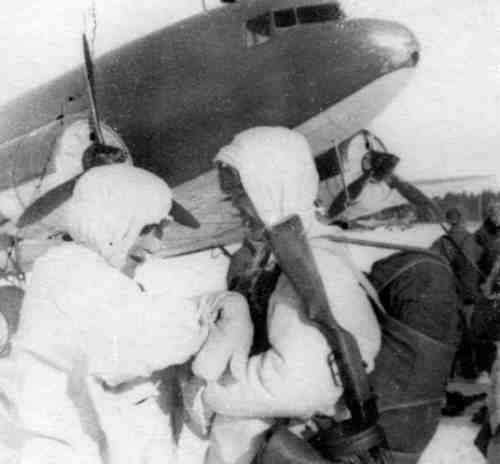
Landing began on January 27 in 14 h 30 mines from the Zhashkovo airfield, dropping by parachute by two flights of PS-84 2 th parachute paratroop battalion - the vanguard 8. The first flight involved 29 aircraft, the second - only 17. Due to an error made by the crews, the battalion was thrown 15-18 km south of Ozerechni from a height of 1500-2000 m (instead of 400-600 m). The paratroopers and materiel were scattered over a distance of 20-25 km around Tabora. 648 28 people were collected from 476 airborne by January morning 30. At the appointed place, it was also possible to concentrate around XNUMX% parachute soft bags (PMM) with food, weapons, ammunition and skis.
On the night of January 29, 500 parachutes of a pair of skis, shells, mines, grenades, rifle cartridges and 400 drags were dropped into the Ozerechni area. After this flight, only 10-11 transport aircraft were in good condition. Some of the vehicles were shot down or damaged by the enemy in the air, others were destroyed at the airfields, and some turned out to be faulty, largely due to the bad choice for landing the landing of the Kaluga airfield hub (located 40 km from the front, in the zone of active air and undercover intelligence of the enemy) and weak observance in parts of measures of secrecy and disguise. All three airfields: in the region of Kaluga, Rzhavtsa and Zhashkova — were continuously attacked by the enemy, and the enemy fighters met the rising vehicles.
In the current situation, transport aircraft from January 28 began to make only night flights. February 1 further landing of parts of the hull from the Kaluga aerodrome hub was generally decided to stop. For six days of work, transport aviation managed to land 2497 people (85% 8 vdbr) and 34400 kg of cargo (weapons, ammunition, food, skis, medicines) in the Vyazma region.
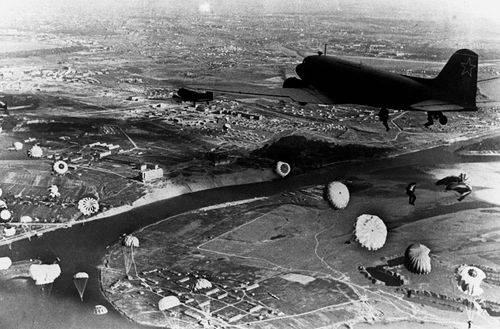
The 4 VDK command, the 9 and 214 units, and the remaining 8 battalion, the command, were returned by rail to the airfields near Moscow. Preparation began for the further landing of corps parts. From this point on, the headquarters of the rear of the Western Front (Chief of Staff Colonel DS Dollad), together with representatives of the directorates of the commanders of the Airborne Forces and the VTA, began to prepare a plan for the logistics of the landing force. The new plan has also been repeatedly modified and updated.
Planning new tasks for the 4 VDK, the headquarters of the Western Front and the command of the Airborne Forces took measures to prevent the repetition of the previously made mistakes: the corps commander received intelligence information about fascists in the drop zone; the air group for landing 4 VDK was reassigned to the commander of the Airborne Forces (41 PS-84 and 23 - TB-3); Moscow airfields began to reliably hide behind the forces of the Moscow air defense zone; a reserve of planes was provided; before the landing, a support team was sent to the landing area, with three radio stations and light signaling. The task of meeting the group was assigned to the commander of the partisan detachment.
However, errors could not be avoided. Landing began late and lasted 7 days (instead of three). Its sequence was broken. Many crews lost their orientation and dropped landing from high altitudes, with a significant deviation from the designated areas. Radio stations were not sent to the landing area. Numerous fires lit by paratroopers, partisans, our troops operating in the German rear, as well as the enemy, disoriented the crews. Fearing mistakes, some crews (around 25%), without completing the mission, returned to the airfield.
Material support was organized as follows. Each paratrooper had in his possession three daily rations of dry rations, 1-1,5 ammunition of rifle ammunition, two hand grenades, a piece of saber, a shovel or an ax. Machine guns, mortars, PTR-s, ammunition, stocks of medicines, medical property and skis were packed in the DUMM and were ejected simultaneously with paratroopers. The reserve of weapons, as well as material resources in case of their losses was not created.
The release of weapons, ammunition and other goods was carried out unsuccessfully: far from the landing of paratroopers and with a range of 15-25 km. Part of the weapons, skis and other property was broken when they hit the ground, ice, trees - the inexperience of the paratroopers in packing cargo in the parachute container affected. Cargo collection was hampered in the conditions of a wooded area and off-road, deep snow cover and poor visibility (night, blizzard), as well as opposition from the ground enemy and his aircraft. In the first two or three days after the release, it was possible to collect only from 30 to 55% of the discharged cargo. The situation required to organize the supply of material means of transport aircraft from the source airfields.
In March-April, 1942-4 tons of materials (ammunition - 15%., Food - 18%, the rest of the goods - 80%) were supplied for 12 per day per day for 8. Most of the supply made ammunition, which allowed battalions and 85 airborne brigades to maintain combat capability. In total, in the period from February 100 to 4 on June 9, in the interests of 19 VDK, air transport groups made 1942 sorties, of which 4 (1868%) were successful. A significant amount of all types of material was delivered to the paratroopers. At the same time, some of the aircraft returned to their original aerodromes without completing the mission.
Difficult delivery by air is the multi-degreeness and complexity of controlling the forces and means of various subordinate instances (airborne vehicles and airfields were subordinated to the Air Force and Civil Air Fleet; transport gliders and PDT handlers - Airborne Forces; aircraft tugs - ADD; appropriate contingent services controlled cargo and container). MTA military support was organized by non-profit organizations, front headquarters, air force, and air defense. The headquarters of the Soviet Army and the front were engaged in transportation. The packaged cargoes brought central and regional warehouses to the airfields. Non-standard teams from the warehouse maintenance units loaded them into planes. Platforms for dumping (unloading) of goods prepared by the troops, which they were intended. They also collected the dumped material resources. There was a shortage of parachute packaging, packaging materials, parachute systems and commands for packing parachutes and loading cargo. It was not easy to organize the coordinated work of all the links of this complex mechanism, especially since the enemy was trying to break it at all stages.
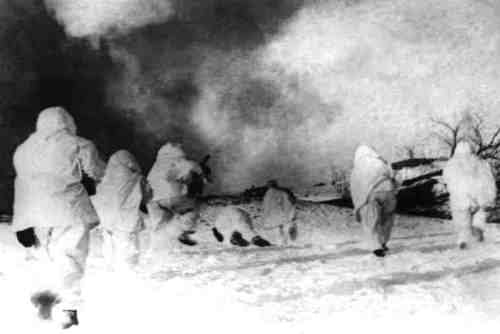
What could not be delivered by air was procured from local funds, and was mined in battle in enemy garrisons. Parts of the 8th BDB alone in the battles of February 8 and 9 captured about 200 cars, 64 motorcycles and even several tanks and armored personnel carriers. Since there were no repairmen and drivers prepared for the restoration and operation of cars, trophies were destroyed, and horse drawn carts and sledges were used as the main vehicle. Drags and skis were also used. Often the goods were delivered by the carriers.
During the fighting, the enemy was seized a significant amount of food, weapons and ammunition (for example, a warehouse at the Ugra station). With the help of the local population, the paratroopers searched the forests for weapons and ammunition left by our retreating forces in 1941. Harvesting food from local means was complicated, since its reserves were devastated by the enemy. In addition, in many localities housed a large number of refugees from Smolensk and other places. For parts of the 4 Vdk and the First Guards Cavalry Corps, the regional committees and district party committees have allocated food resources from collective farms (up to seed funds). Meat products were replenished with personal cattle, which were withdrawn by partisans from people who worked for the enemy (in the councils, elders, policemen). District executive committees also requisitioned livestock from small families. At the same time they were given a written commitment to return it after the liberation of the area from the occupiers.
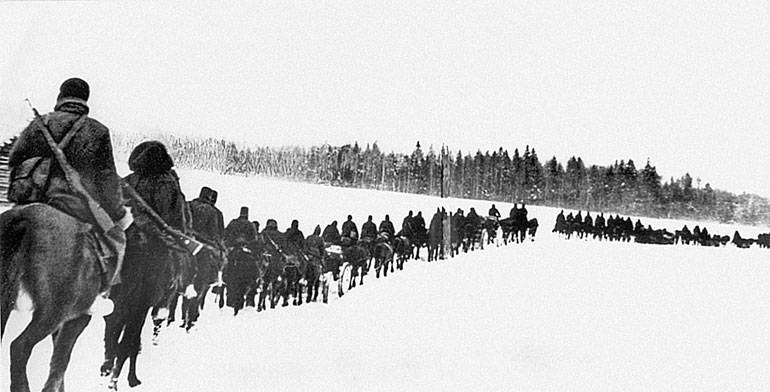
The lack of material resources required the centralization of their distribution. At the headquarters of 4, a non-standard rear control body and two warehouses, ammunition and food, were created. Corps depots covertly deployed in deaf low-habitable places and forests, in the center of the landing zone, at a distance from 4-6 to 10-12 km from the line of combat contact. Not far from them, platforms were being prepared for receiving stocks delivered by aviation, a corpus evacuation receiver was deployed for the wounded waiting for evacuation by airplanes to hospitals of the front. At the disposal of the corps' rear logistics team there was a starting team that provided preparation of sites for cargo discharge and landing of aircraft, as well as a cargo collection and protection team formed at the expense of recovering sick and wounded. Both teams often participated in battles.
Requests for tangible assets with indication of the sites and terms of cargo delivery by cipherradiograms were submitted to the front headquarters. It was delivered by PS-84 aircraft, and in April-May also by light (U-2) and heavy (TB-3) bombers. The return flights evacuated the wounded. The headquarters of the rear of the Western Front reported 4 VDK on the radio, how much and what kind of cargo, when and to what sites will be delivered, and in what package; the number and type of delivery aircraft; signals to indicate landing sites. In the event of cargo dropping on parachutes, the drop height, the number, type and marking of the package were reported. Sometimes planes dropped loads from a flight without parachutes.
Although due to serious deficiencies in the rear, unfavorable weather and limited transport aircraft, the delivery of materiel by air was intermittent, it played an important role in providing parts of the 4 VDK. So, only 20 in March was delivered to the corps by parachute 5 heavy machine guns, 10 82-mm mortars, 1500 shells for 45-mm guns, 900-82- and 50-mm min, 200 kg of sanitary equipment, around 7-XNHM, 8-XNUMX-XNUMX-mm min. In April, the spring thaw began. Neither the sleigh, nor the wagons for the delivery of material resources could not be used. I had to bring everything I needed with packs on horses, and sometimes I had to wear it myself.
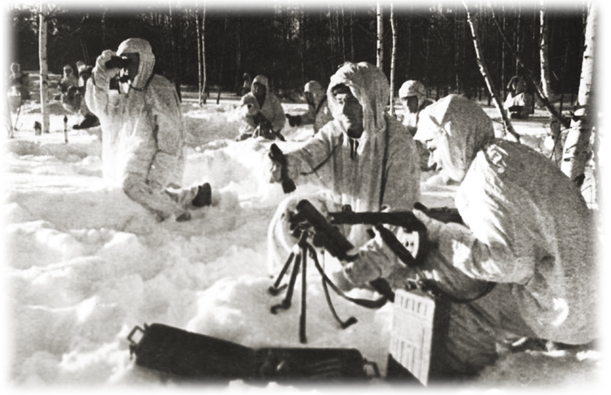
Material resources from the corps warehouses were supplied to the brigade, and from them to the battalion. The battalions often received supplies directly from corps warehouses. Sometimes cargoes were dumped into areas where battalion warehouses are located by U-2 aircraft from low altitudes to the nearest roads and roads to the warehouse. Brigade warehouses were located in the center of the combat area, not far from the battalions' battle formations: on the offensive - in 1-2 km, in the defense - in 3-4 km. Warehouses were located in the forest and in ravines, sheltered from observation, convenient for defense. They were protected by convalescent teams. Circular defense was organized around the warehouses, observation posts, patrols and patrols were set up. The personnel of the rear units was armed, except for submachine guns and rifles, grenades and machine guns.
During the period of raid operations and when leaving the encirclement, air cargo delivery was seriously complicated. The corps filed applications while on the move. The front rear headquarters responded slowly to incoming requests, often being late with information about the supply of cargoes by airplanes. Parts of the corps went to new areas, and the arriving planes looked for them in former ones. Sometimes they could not collect the dumped cargo of the corps unit. Crews, on the other hand, did not find the start teams at the designated points, and often returned to the airfields.
In order to increase the responsibility of crews for the delivery of materiel to paratroopers, the order obliged to mark all the cargoes with a number assigned to the aircraft. The head of the rear of the front had to daily inform the recipients what goods, where, how and when they will be delivered. Recipients undertook to immediately report when, which goods and under what numbers were received, which were not delivered, broken or were not dumped in the indicated place. The crews of TB-3 undertook to make one, and PS-84 at least two sorties per night. Crews that deliver cargo well by airborne troops were ordered to submit to state awards, and to investigate all the facts of non-compliance with the tasks. The measures taken significantly improved the supply of troops. However, the intense battles that began in late May almost completely eliminated the possibility of planned aviation supply of airborne units.
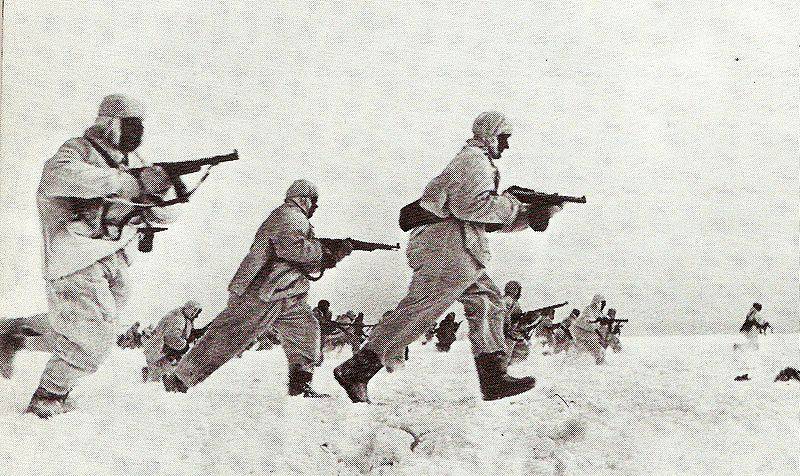
Medical support of the operation had its own characteristics. According to the states, each company in the IDR was supposed to have a medical orderly; in the medical center of the battalion - a doctor, paramedic, medical orderly, two orderlies, in brigade first-aid stations - three doctors, as well as a medical assistant, heads of pharmacies and laboratories, medical orderly, medical orderly and driver. The staffing was incomplete. Most of the first-aid posts (60%) were dumped far from their parts and connections, and for a long time could not serve the wounded. The collection of first-aid posts continued until March. Before the landing, the medications and medical assets were divided into portable stocks and supplies, parachuted into the PMMM. Wearable stocks included three types of medical bags: a medical assistant (outpatient, dressing) bag, a bag of medical orderlies and orderlies, a bag of additional stocks of dressings. Each battalion medical center (BMP) was allocated on a set of B-1 (bandages), B-2 (tires), anti-chemical bag (PHC), as well as additional stocks of iodine, alcohol. All stocks were dumped into 4-5 PDMM. Part of the sets B-1 was dumped in ordinary bags without parachutes. The stretcher was tied to PDMM from above. Each paratrooper was provided with two individual packages. Doctors brigades received surgical instruments. After landing, a part of the medical property dumped in the DUMM could not be found, which made it difficult to assist and evacuate.
Shortly after being released by the decision of the corps commander, the medical service of the corps, headed by the 2 military doctor rank II, was created from military and civilian medical workers. Molchanov. The front sent several doctors to reinforce the corps, and in March began delivering canned blood, alcohol, and ether. The medical service received a part of the medical property from local medical institutions, as well as trophies seized from the enemy. Dressings often replaced parachute fabric.
With the help of partisans and local authorities, improvised hospitals were deployed in public buildings and private houses in sheltered and poorly accessible places. In the spring of the hospital deployed in the forest, in tents. Their teams were lightly wounded and convalescent. All the wounded were left with personal weapons, and they were included in the combat crew of all-round defense in the event of an enemy attack.
Wounded from the battlefield were carried out by non-staff paramedics, porters of divisions, partisans, local residents. From the mouths, the wounded were evacuated to the BMP deployed one and a half kilometers from the front line, and then to the BRMP and further to the hospitals, taking into account their specialization. In the medical units there was a lack of medicines, underwear, soap, there was no stretcher and no transport. The light-wounded usually traveled by themselves, the seriously wounded were transported on carts. Sometimes the wounded had to be manually evacuated on improvised stretchers. Even with a lack of food, every wounded person received daily 300 grams of rye bread, 200 grams of meat, potatoes and other products. In the first-aid posts and hospitals, hot food was provided. When leaving the encirclement, part of the non-transportable wounded paratroopers were handed over to the partisan detachments. Later they were evacuated by airplanes in the hospital of the front. In total, about 3600 wounded and sick passed through the corps hospital. Of these, 2136 (60%) returned from the corps hospital to the system, 819 people evacuated by aviation. Part of the wounded left the enemy rear, along with the torn troops.
The experience of the Vyazma airborne operation showed that the rear organs of the airborne formations and units were few in number, poorly prepared, and under difficult conditions could not successfully solve the tasks entrusted to them. On the agenda there was a question about strengthening the rear parts and strengthening the managerial level. In this regard, the post of deputy commander of the brigade for rear was introduced to the headquarters of the brigade headquarters in August 1942. Chiefs of artillery, military-technical, food and clothing supply of the brigade, head of financial allowance, brigade doctor submitted to him. The brigade contained four warehouses: food, artillery weapons, parachute and clothing property. In the new state, the brigade had an artillery workshop and a transport platoon.
Much of the experience of logistic support in the Vyazma operation was later taken into account during the Dnieper airborne operation, which took place from September 24 to November 13, 1943. So, to ensure the landing of 1, 3 and 5 Guards. It was planned to attract significant transport aviation forces — the 180 of the Li-2 and 35 gliders. For submission of material to the landing force after its dropping at the airfields, one ammunition load and two food delivery days were packed at the airfield camp. The rates of reserves held by the personnel in the warehouses of the airborne battalions and brigades were determined in advance. Especially for the evacuation of the wounded, an aviation detachment of X-NUMX U-10 aircraft was allocated, and a detachment of X-NUMX Li-2 aircraft was provided for the delivery of cargo to the landing party. Each paratrooper had food for two days and an 25-2 ammunition ammunition.
However, in the course of this operation, too, there were errors and miscalculations characteristic of the Vyazma operation. So, intelligence did not reveal the German group in the area of the release. The training of crews and units of military transport aviation continued to remain weak. Landing was carried out by single aircraft, from high altitudes, with a significant deviation of emission sites from the planned areas. This led to a significant dispersion of airborne troops and materiel. The experience of logistic support of the Vyazma airborne operation showed that to control the units and agencies of the rear involved in the airborne operations, a single centralized command body with the appropriate rights, forces and means is necessary, that the issues of the logistics of airborne assault forces must be coordinated with the command and the head of the rear of the association, in whose interests the landing operation is being conducted.
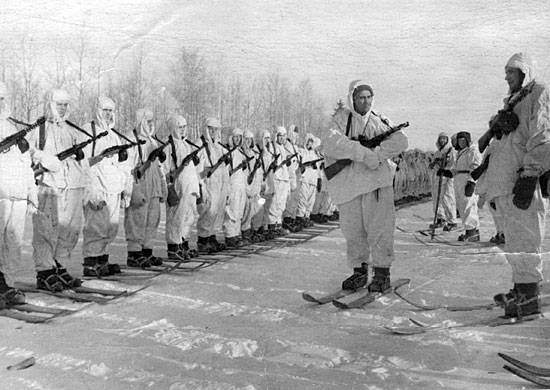
The airborne corps needed not only a military but also an airmobile corps rear. At the same time, the rear of the airborne formations should be ready for long autonomous actions, and the rear units should be engaged in combat, both with ground and airborne adversaries. Regular delivery of material to the landing force by air is possible only if the enemy’s air defense system is reliably suppressed, in the overflight zone of military transport aircraft. All these findings affected the further development of our airborne forces.
Sources:
Goncharov V. Vyazemsky airborne operation // Landing forces of the Great Patriotic War. M .: Yauza, Eksmo, 2008. C.269-338
Sofronov G. Airborne assault forces in the Second World War. M .: Voenizdat, 1962. C.48-62.
Sorochenko L. Planning miscalculations. // visage 1987. No.1. C. 78-86
Belov P. For us, Moscow. M .: Voenizdat, 1963. C. 198-220
Lisov I. Marines M .: Voenizdat, 1968. C.34-49.
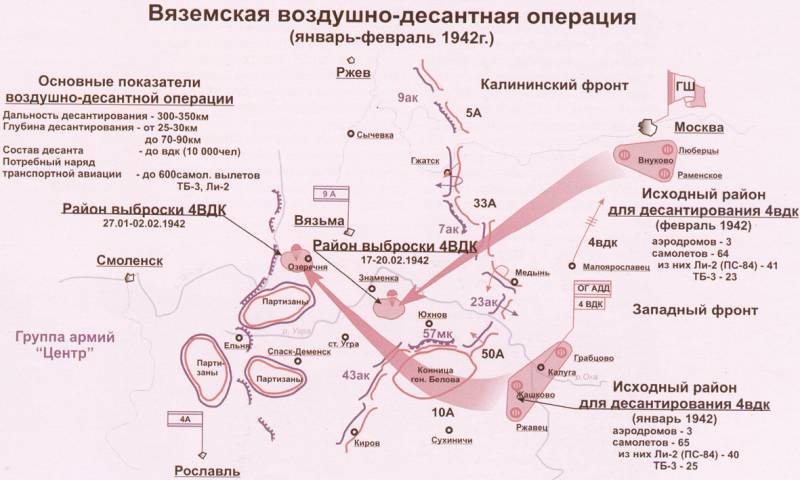
Information